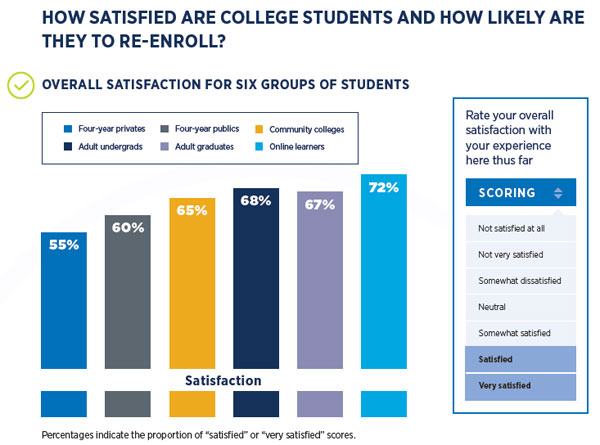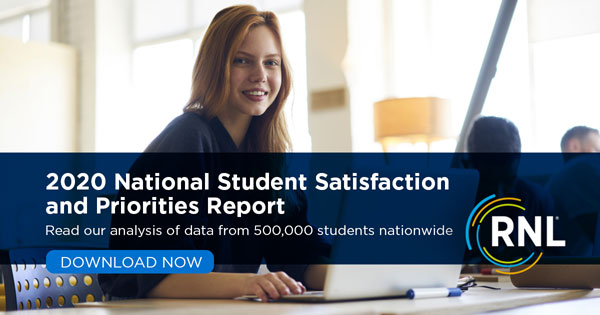student success
Assessing Student Satisfaction Is More Important Than Ever
For 25 years, 3,000 colleges and universities have partnered with RNL for assessing student satisfaction, and every year we publish benchmarks based on data from hundreds of thousands of student responses about their satisfaction and priorities. Our latest benchmarks in the 2020 National Student Satisfaction and Priorities Report use data from more than 506,000 students at 793 institutions, and they reflect consistent levels of student satisfaction for six populations.

These scores are important to monitor because evidence-based research has documented strong links between students’ scores on this item and individual student retention, institutional graduate rates and institutional alumni giving rates.(For more details, see our infographic, Why Does Student Satisfaction Matter?)
Looking back as we need to look forward
This year’s national report aggregates data from the 2017-18, 2018-19, and the 2019-20 academic years.The majority of the responses are pre-pandemic, which makes this report a snapshot of student satisfaction before COVID-19.This means that these benchmarks provide insight into the “old normal” as the “new normal” begins to take hold on college campuses.
Going forward, higher education will need to create new benchmarks for the post-pandemic environment as we begin to document how satisfied students are with institutional actions, support systems, online/hybrid instruction, and overall safety measures.
This year’s report documents the level of importance and satisfaction in four key areas, pre-pandemic:
1. Tuition paid is a worthwhile investment
This item provides insight into students’ perceptions of the value they place on their financial investment in their education. This will be a benchmark to monitor closely to see how the shift to online and hybrid experiences impacts students’ perception of the cost and value of tuition.
2. Adequate financial aid is available for most students
The availability of financial aid is a key factor in the decision to enroll for many students, and financial assistance may become more critical for students and their families who have suffered economically from the pandemic.
3. The quality of instruction is excellent
The perception of high quality instruction gets right to the heart of what most institutions expect to offer their students and what students expect from their college experience. Student satisfaction levels can vary, however, and as with tuition being seen as a worthwhile investment, this could change particularly among students who identify as being enrolled primarily on-campus but are taking courses online.
4. The campus is safe and secure for all students
The sense of being safe and secure on campus is currently one in terms of physical threats, but likely in a post-pandemic world, students’ perceptions will be related to the ability of the campus to keep them safe from the virus as well.
Assessing student satisfaction in our current environment
In this rapidly changing environment, assessing student satisfaction is more important than ever. What you thought you knew about your student population before the 2020 pandemic may not match up with their current perceptions and priorities—and you will not know unless you assess them. Waiting until higher education returns to “normal” isn’t an option. Your student populations will have had a least a portion of their educational experience online from the spring of 2020 as well as potentially into the 2020-21 academic year. They will have experienced how you responded to a crisis situation, what policies you implemented, what technical support you were able to provide, the adjustments made to fees and financial assistance, along with the quality of education you provided during an evolving situation.
As you set your course going forward with potentially reduced budgets and bigger demands, understanding the priorities of your students will play a significant role in determining where resources are spent to best serve and retain your student population. Take a moment to look back with the results from the 2020 National Student Satisfaction and Priorities Report, and then going forward, I invite you to learn more about gathering similar data for the student populations you serve. The Satisfaction-Priorities Surveys from RNL offer versions for traditional students, adult undergraduate, and graduate students as well as students enrolled one hundred percent online.

